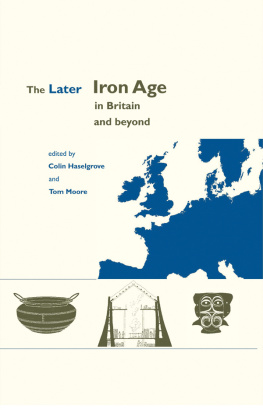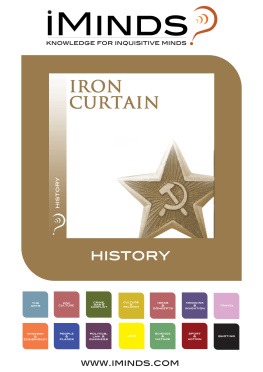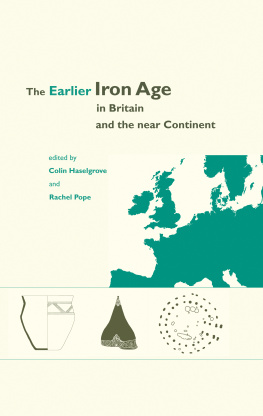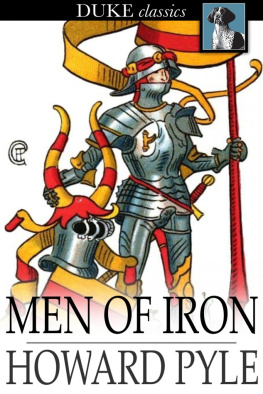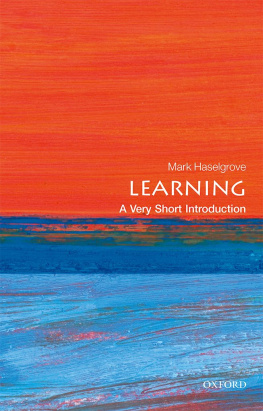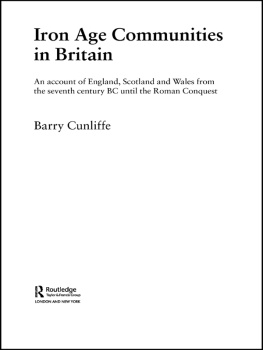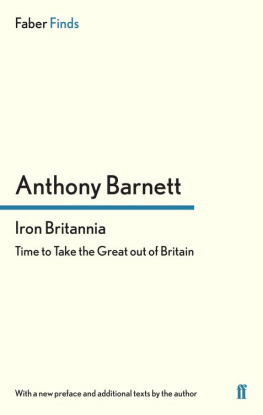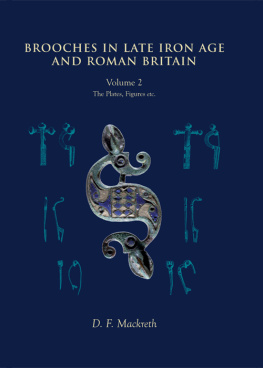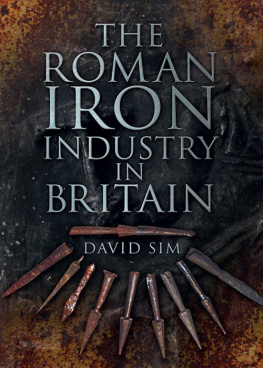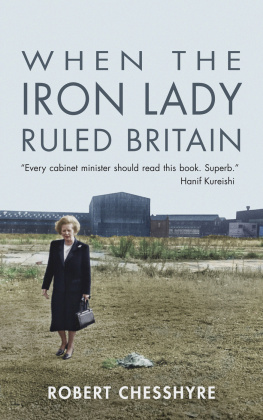Tom MooreElizabeth MooreColin Haselgrove - The Later Iron Age in Britain and Beyond
Here you can read online Tom MooreElizabeth MooreColin Haselgrove - The Later Iron Age in Britain and Beyond full text of the book (entire story) in english for free. Download pdf and epub, get meaning, cover and reviews about this ebook. year: 2006, publisher: Casemate Publishers & Book Distributors, LLC, genre: Politics. Description of the work, (preface) as well as reviews are available. Best literature library LitArk.com created for fans of good reading and offers a wide selection of genres:
Romance novel
Science fiction
Adventure
Detective
Science
History
Home and family
Prose
Art
Politics
Computer
Non-fiction
Religion
Business
Children
Humor
Choose a favorite category and find really read worthwhile books. Enjoy immersion in the world of imagination, feel the emotions of the characters or learn something new for yourself, make an fascinating discovery.
- Book:The Later Iron Age in Britain and Beyond
- Author:
- Publisher:Casemate Publishers & Book Distributors, LLC
- Genre:
- Year:2006
- Rating:5 / 5
- Favourites:Add to favourites
- Your mark:
- 100
- 1
- 2
- 3
- 4
- 5
The Later Iron Age in Britain and Beyond: summary, description and annotation
We offer to read an annotation, description, summary or preface (depends on what the author of the book "The Later Iron Age in Britain and Beyond" wrote himself). If you haven't found the necessary information about the book — write in the comments, we will try to find it.
The Later Iron Age in Britain and Beyond — read online for free the complete book (whole text) full work
Below is the text of the book, divided by pages. System saving the place of the last page read, allows you to conveniently read the book "The Later Iron Age in Britain and Beyond" online for free, without having to search again every time where you left off. Put a bookmark, and you can go to the page where you finished reading at any time.
Font size:
Interval:
Bookmark:

T HE L ATER I RON A GE IN B RITAIN AND B EYOND
edited by
Colin Haselgrove and Tom Moore
Oxbow Books
First published in the United Kingdom in 2007. Reprinted in 2017 by
OXBOW BOOKS
The Old Music Hall, 106108 Cowley Road, Oxford OX4 1JE
and in the United States by
OXBOW BOOKS
1950 Lawrence Road, Havertown, PA 19083
Oxbow Books and the individual contributors, 2007
Paperback Edition: ISBN 978-1-78570-910-4
Digital Edition: ISBN 978-1-78297-552-6 (epub)
Mobi Edition: ISBN 978-1-78297-553-3 (mobi)
A CIP record for this book is available from the British Library
All rights reserved. No part of this book may be reproduced or transmitted in any form or by any means, electronic or mechanical including photocopying, recording or by any information storage and retrieval system, without permission from the publisher in writing.
For a complete list of Oxbow titles, please contact:
| UNITED KINGDOM | UNITED STATES OF AMERICA |
| Oxbow Books | Oxbow Books |
| Telephone (01865) 241249, Fax (01865) 794449 | Telephone (800) 791-9354, Fax (610) 853-9146 |
| Email: | Email: |
| www.oxbowbooks.com | www.casemateacademic.com/oxbow |
Oxbow Books is part of the Casemate Group
Cover by Christina Unwin based on an idea by Rachel Pope; reconstruction of burial by Simon James
The nature and causes of the changes that took place in the last centuries of the Iron Age, particularly in southern Britain, have been a major focus of interest ever since Evans (1890) pioneering study of the Aylesford cemetery and its continental antecedents. The idea of a culturally distinct Late Iron Age in south-east England triggered by Belgic immigrants (Iron C) was formalised in the earlier twentieth century (e.g. Hawkes and Dunning 1931) and retained its significance even after Roy Hodson deconstructed invasion as the primary agent of change in Iron Age Britain. Emphasising the long trajectory of insular groups, Hodson (1964) replaced the by now over-complex ABC system (Hawkes 1959) with a simpler binary opposition, between an essentially indigenous early pre-Roman Iron Age lasting up to c. 100/50 BC, followed by a late pre-Roman Iron Age, defined by the introduction of La Tne D metalwork to Britain, and by the inception of the Aylesford culture acknowledged as a distinctive, foreign element in south-east England. Elsewhere, the Woodbury Culture (Late) held sway up to, and in many highland areas beyond, the Roman conquest, although now subject to strong continental influences, reflected in innovations like coinage, rotary querns, and wheel-made pottery. Owing to the late dating in vogue in the 1960s, Hodson attributed several features to his late phase which Hawkes and his generation associated with Iron B and which we too would now see as much earlier including currency bars, elaborate multivallation and decorated saucepan pottery.
Hodsons model of steady development from the Bronze Age followed by a short period of continentally-induced changes was adopted by Barry Cunliffe (1974a) for his highly influential Iron Age Communities in Britain , both in his initial presentation of the material (
Since the 1970s, most discussions of Late Iron Age developments have followed Cunliffes lead, firstly by focusing on south-east England, and secondly, by invoking mainly external causes. What the relevant changes actually represented has been largely a matter of theoretical fashion: in the brief heyday of processualism, they were construed as urbanisation linked to the intensification of external trade (Cunliffe 1976; 1978; Haselgrove 1976); in the 1980s, they became the rise and fall of paramount chiefdoms fuelled by Roman trade in prestige goods, as in the coreperiphery model (Haselgrove 1982; 1984; 1987; Cunliffe 1988; 1991); nowadays, they are viewed as dynasty building and the adoption of continental-style identities, driven by Roman political agency and cultural imperialism, and even migration (Millett 1990; Creighton 2000; 2006; Hill 2002). There have been some attempts to explain the changes of the Late Iron Age in more local terms and to play down the role of external trade, but these have been in the minority, and, perhaps significantly, have been directed at areas outside south-east England (e.g. Fitzpatrick 1989; 2001; Sharples 1990).
Partly under the growing influence of post-processual approaches, disquiet about the then current models of the Late Iron Age and especially the focus on south-east England began to be voiced in the late 1980s and continued to mount up through the 1990s. As Haselgrove (1989, 13) noted, little attention was given to the formative role of the Middle Iron Age, despite growing evidence to suggest that many supposedly Late Iron Age changes began earlier or were rooted in changes prior to the first century BC. The prevailing orthodoxy was also at variance with Iron Age studies in continental Europe, where the Middle La Tne period is widely regarded as marking a radical realignment in social structures (e.g. Duval 1976; Bintliff 1984; Haselgrove 1990; Pion 1990; Collis 1995; Kristiansen 1998). Haselgrove (1989) called for more research on the social and economic changes in the rest of Britain, which the new settlement data being generated by rescue archaeology suggested were more far reaching and extensive than had hitherto been thought, a view that subsequent work has reinforced (e.g. Hill 1995; 2002; Armit 1999; Haselgrove 1999a; 2004). It is now apparent that the archaeological record left by Iron Age communities outside the pottery- and burial-rich areas of southern Britain, far from being impoverished, has been distorted by complex cultural and depositional factors, whilst the apparent coexistence of culturally Middle and Late Iron Age groups in parts of southern Britain has cast further doubt on this terminology (Hill 1995), even where it once seemed to make sense
Reflecting these concerns, the recent review of research on Iron Age Britain called for new narratives to be developed to explain the widespread transformation in settlement, social structure, and material culture from c. 400300 BC onward (Haselgrove et al. 2001, 2831). The present book has its origins in a seminar on this theme held at the University of Durham in March 2002. The meeting also sought to set British developments in a wider geographical context by inviting papers on neighbouring countries such as Denmark, Ireland and the Netherlands. Further papers have since been added to enhance the regional coverage (Cripps; Davies; Frodsham et al.; Hamilton; Haselgrove), or to address other topics (Collis; Macdonald; Van der Veen and Jones). As we will see, the contributors offer a diversity of approaches and many papers also eschew traditional boundaries, instead seeking an integrated analysis of community and identity. While not excluding the highly visible changes in south-east England (e.g. Bryant; Carr; Hamilton; Hill), the majority of contributions focus on regions and topics that have received less attention in the past. We will begin with a brief discussion of terminology and of the new theoretical directions that have started to take shape in Iron Age studies, before going on to examine the specific themes in more detail.
In this book, the Later Iron Age is taken to cover the period from c. 400300 BC onward until the Roman conquest. Such a framework is more appropriate to the many regions of the British Isles and north-west Europe that lack a distinctive Late Iron Age horizon characterised for example by oppida or wheel-made pottery, and where significant changes can be argued to have begun rather earlier and/or to have been played out well into the first millennium AD (e.g. papers by Armit; Hunter; Webley). Whilst the traditional terminology is retained in some papers, there is nonetheless a mood not to be constrained by rigid chronological divisions wherever other temporalities are implied by the material, and general agreement that Late Iron Age developments can only be fully understood in a wider temporal and geographical context.
Next pageFont size:
Interval:
Bookmark:
Similar books «The Later Iron Age in Britain and Beyond»
Look at similar books to The Later Iron Age in Britain and Beyond. We have selected literature similar in name and meaning in the hope of providing readers with more options to find new, interesting, not yet read works.
Discussion, reviews of the book The Later Iron Age in Britain and Beyond and just readers' own opinions. Leave your comments, write what you think about the work, its meaning or the main characters. Specify what exactly you liked and what you didn't like, and why you think so.

